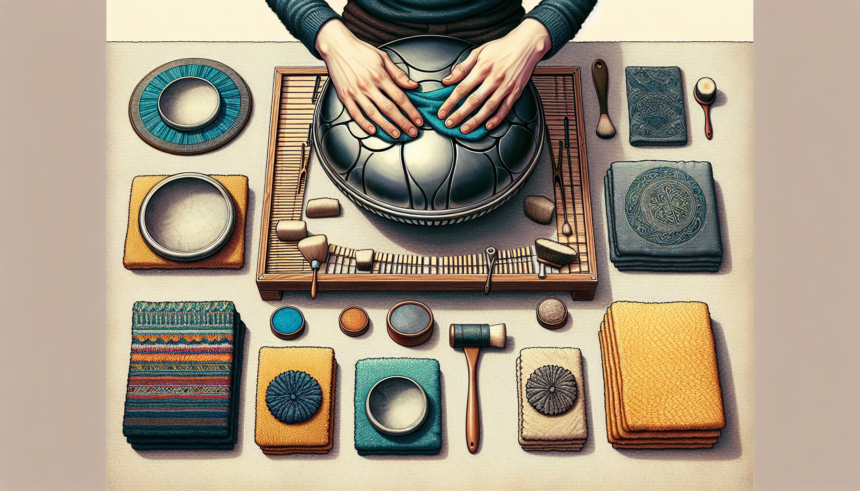Handpans, known for their unique sounds and captivating designs, require diligent care to maintain their beauty and integrity. One crucial aspect of this maintenance is the regular polishing of the instrument’s surface. Polishing not only keeps the handpan looking great but also helps in removing any fingerprints, dirt, and potentially corrosive substances that can inhibit its longevity. The type of polishing cloth you use can significantly influence the effectiveness of the cleaning process. This article provides a detailed comparison of different polishing cloths suitable for handpans, evaluating each material based on its softness, durability, absorbency, and overall effect on the instrument.
Microfiber Cloths
Microfiber cloths are highly popular for cleaning musical instruments, including handpans. These cloths are made from synthetic fibers that are finer than a strand of silk. Microfiber is known for its exceptional absorbency and softness, making it gentle on delicate surfaces.
Advantages
- Non-abrasive: The fine fibers ensure that the cloth does not scratch the surface of the handpan.
- Highly absorbent: Microfiber can soak up several times its weight in water, making it effective at cleaning and drying.
- Durable: They can withstand multiple washes without losing efficacy.
Disadvantages
- Lint issues: Lower quality microfiber cloths may leave lint behind.
- Cost: Higher quality microfiber cloths can be more expensive than other options.
Chamois Leather Cloths
Chamois leather, made from the skin of the chamois goat-antelope or from sheepskin, is another excellent option for polishing handpans. This material is renowned for its softness and absorbency.
Advantages
- Gentle on surfaces: The natural softness of chamois leather prevents scratching.
- High absorbency: Chamois can absorb a significant amount of moisture and oil.
- Reusable: With proper care, these cloths can last for a long time.
Disadvantages
- Maintenance: Chamois requires specific care to maintain its quality and softness.
- Initial stiffness: New chamois cloths can be stiff and require conditioning before use.
- Cost: Genuine chamois leather can be quite expensive.
Flannel Cloths
Flannel is a soft woven fabric, typically made from cotton or wool. It’s a popular choice for polishing and cleaning due to its gentle texture.
Advantages
- Softness: Flannel is gentle on the handpan surface, reducing the risk of scratches.
- Affordable: Usually less expensive than microfiber or chamois leather.
- Good absorbency: Suitable for absorbing oils and moisture effectively.
Disadvantages
- Durability: May not hold up as well as microfiber or chamois with repeated washing and use.
- Lint problems: Can leave behind lint, especially when new.
- Less availability: Flannel specialized for polishing might be harder to find.
Silk Cloths
Silk cloths are made from natural silk fibers, well-known for their smooth texture and luxurious feel. They are often used in delicate situations due to their extremely gentle nature.
Advantages
- Non-abrasive: Silk is incredibly gentle and will not scratch the handpan surface.
- Effective cleaning: Excellent for removing fingerprints and smudges without the need for excessive rubbing.
- Natural shine: Can help bring out the natural shine of the handpan.
Disadvantages
- Cost: Silk cloths can be relatively expensive compared to other materials.
- Durability: May not be as durable or long-lasting as microfiber or chamois.
Cotton Cloths
Cotton cloths are a common choice due to their affordability and availability. They come in various forms, including terry cloth, muslin, and basic cotton rags.
Advantages
- Affordable: Cotton cloths are generally inexpensive and readily available.
- Versatility: Available in different weaves and textures for various polishing needs.
- Non-scratch: When used properly, they are gentle on the handpan surface.
Disadvantages
- Lint production: Some cotton cloths can leave behind lint and fibers.
- Durability: May wear out faster than microfiber or chamois, especially if not tightly woven.
- Absorbency: Less absorbent than microfiber or chamois, requiring more effort to clean effectively.
Conclusion
Choosing the right polishing cloth for your handpan is essential for maintaining its appearance and preserving its lifespan. Each type of cloth has its own set of advantages and disadvantages. Microfiber cloths emerge as a popular choice due to their high absorbency, durability, and softness. Chamois leather is another excellent option, particularly if you are looking for a natural material with outstanding absorbent qualities. Flannel cloths provide a good balance of softness and affordability, but they might not be as durable as microfiber or chamois. Silk cloths offer a luxurious feel and non-abrasive cleaning, although they come at a higher cost and with less durability. Cotton cloths are the most accessible and versatile option, though they may not perform as well in terms of lint and durability.
Ultimately, the best choice will depend on your specific needs and preferences. It is always a good idea to test a small inconspicuous area of your handpan first, no matter which type of cloth you decide to use.
FAQs
Q1: Can I use paper towels or tissues to polish my handpan?
A: It is generally not recommended to use paper towels or tissues as they can be abrasive and may leave behind lint and fibers. It is better to use a cloth specifically designed for polishing delicate surfaces.
Q2: How often should I polish my handpan?
A: The frequency of polishing depends on how often you play and the environment in which you store the handpan. Regular cleaning after each use and a thorough polish once every few weeks can help maintain its appearance and prevent corrosion.
Q3: Can I wash my polishing cloth?
A: Yes, most polishing cloths can be washed. For microfiber and chamois cloths, it is best to follow the manufacturer’s care instructions. Avoid using fabric softeners or bleach as they can affect the cloth’s performance.
Q4: What type of cleaning solution should I use with my polishing cloth?
A: It is recommended to use cleaning solutions specifically designed for handpans or other sensitive surfaces. Avoid using harsh chemicals, as they can damage the finish of your instrument.
Q5: How do I prevent my handpan from developing rust?
A: Regular cleaning and polishing with a suitable cloth and proper storage are key. Keep the handpan in a dry environment and use desiccant packets to absorb excess moisture. Applying a thin coat of protective oil, specifically designed for handpans, can also help prevent rust.





